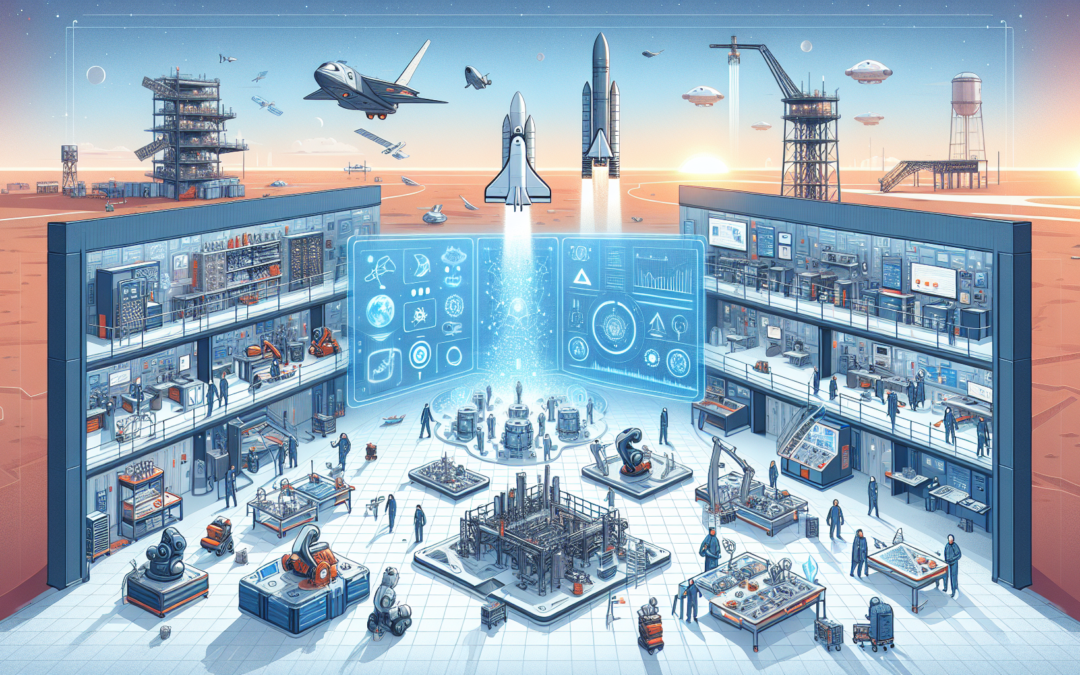Understanding Artificial Intelligence in the Context of Aerospace Facilities
Artificial Intelligence (AI) has become a transformative force within the aerospace sector, offering extraordinary opportunities and breakthroughs in how we design, manufacture, and manage aerospace facilities. The infusion of AI into these facilities heralds a new era of efficiency, safety, and innovation, where complex algorithms and machine learning techniques are being used to streamline processes, predict maintenance issues, and optimize the use of resources.
Supply Chain and Logistics Optimization is one of the prominent areas within aerospace facilities where AI is making significant inroads. By leveraging predictive analytics, aerospace facilities can foresee potential disruptions in supply chains and adapt logistics strategies accordingly. This level of predictive capability allows for smarter inventory management, reducing waste and costs by ensuring the right parts are available at the right time, without overstocking.
AI-Driven Predictive Maintenance
Another critical application of AI in aerospace facilities is in the realm of predictive maintenance. The ability to predict when machinery or components are likely to fail by analyzing data trends is crucial in minimizing downtime and preventing costly unplanned maintenance. AI algorithms monitor the health of equipment, learning from historical data to provide timely alerts before breakdowns occur. This proactive approach significantly enhances the longevity of aerospace facility infrastructure and equipment.
Enhanced Design and Simulation Capabilities
At the drawing board, AI is reshaping how aerospace facilities conceptualize new projects and retrofit existing structures. Advanced AI-powered design software can simulate countless scenarios, varying materials, and environmental conditions to arrive at the most efficient, cost-effective, and safe designs. This capability allows engineers to test and refine their ideas in a virtual space, dramatically accelerating the innovation cycle of aerospace facilities and reducing the risk of failure in real-world applications.
Moreover, AI’s integration into operational management systems within aerospace facilities improves real-time decision-making. By constantly analyzing data from facility operations, AI can offer insights into the optimization of workflows, energy consumption, and even human resource allocation. The resulting improvements in facility management not only drive down costs but also enhance the overall productivity and throughput of aerospace operations.
How AI Enhances Predictive Maintenance in Aerospace Facilities
Predictive maintenance has radically transformed efficiency within aerospace facilities. The integration of Artificial Intelligence (AI) into maintenance strategies is particularly groundbreaking, significantly reducing downtime and increasing aircraft availability. AI algorithms are designed to analyze voluminous data sets, which includes logs, sensor readings, and past maintenance records. By processing this massive amount of information, AI provides an unparalleled insight into equipment health, allowing for timely intervention before issues escalate into costly repairs or operational halts.
AI-driven predictive maintenance leverages machine learning models that are capable of identifying patterns that signal potential equipment failures. These models continuously learn and improve over time, making the maintenance processes in aerospace facilities not just reactive but intelligently proactive. For instance, AI can predict the lifespan of engine components with high accuracy, scheduling maintenance only when necessary and avoiding the conventional time-based approaches that often lead to unnecessary checks or unexpected breakdowns.
Beyond mere prediction, AI systems support maintenance personnel with decision-making tools. Through real-time analytics and diagnostics, maintenance teams at aerospace facilities can prioritize their work more effectively. AI algorithms can suggest the most likely cause of a detected anomaly, recommend the best course of action, or even automate certain maintenance tasks, which allows for optimization of human resources and a reduction in the margin of error associated with manual interventions.
The use of AI in predicting maintenance needs also has implications for inventory management. Aerospace facilities can maintain a leaner inventory by using AI to predict which parts will be required and when. This just-in-time inventory strategy can lead to significant cost savings and a more efficient supply chain. In an industry where timing and reliability are critical, the predictive capabilities provided by AI create a substantial competitive advantage for aerospace facilities, ensuring they can maintain continuous operation with minimal interruption.
Optimizing Supply Chain and Inventory with AI in Aerospace Management
In the competitive realm of aerospace management, the optimization of supply chain and inventory is paramount for maintaining efficiency and reducing overheads. By integrating Artificial Intelligence (AI) into these critical areas, aerospace companies can preemptively identify shortages and bottlenecks, forecast demand more accurately, and thereby minimize the risk of overstocking or under-stocking. With AI’s predictive analytics, these organizations are transforming how they manage inventory, resulting in leaner operations and improved cost-effectiveness.
Streamlining Procurement and Logistics
The employment of AI in procurement and logistics within aerospace management enhances decision-making capabilities. Sophisticated algorithms can process vast arrays of data, tracking component quality, supplier performance, and delivery times. By leveraging this data, AI provides actionable insights that allow for the fine-tuning of procurement strategies. Enhanced supplier selection and inventory acquisition result in significant cost savings and an increase in operational reliability.
AI-Driven Forecasting Accuracy
In aerospace management, accurate demand forecasting is vital for maintaining a balanced inventory. AI-powered forecasting models take into account historical data, market trends, seasonal fluctuations, and geopolitical events, all of which could impact supply and demand. This analysis allows for a more precise prediction of parts and materials requirements, ensuring an optimal inventory level that aligns with the actual aerospace market needs. With these advanced tools, managers can combat the costly effects of inventory obsolescence and scarcity.
Data analytics in AI provide real-time visibility into supply chain operations, a critical factor for aerospace companies in anticipating and reacting swiftly to industry changes. This visibility extends not only to inventory management but is also crucial in recognizing and mitigating potential disruptions. Intelligent automation and machine learning further refine the efficiency of these systems, quickly adjusting parameters in response to new data, which supports proactive rather than reactive supply chain management. By using AI to optimize these key areas, aerospace firms are setting new standards in operational excellence.
Improving Safety and Compliance with AI in Aerospace Environments
The advent of Artificial Intelligence (AI) has revolutionized numerous industries, with aerospace being no exception. AI’s role in enhancing safety and compliance within this sector cannot be understated. High-stakes environments like aerospace demand the utmost precision and efficiency, and AI systems are uniquely capable of delivering on both fronts. By leveraging sophisticated algorithms and machine learning techniques, AI contributes to a significant reduction in human error, which has historically been a leading factor in aerospace incidents.
One of the key ways AI improves safety is through predictive maintenance. Traditional maintenance schedules rely on predetermined intervals, but AI can predict potential failures before they occur. By analyzing vast quantities of data, AI determines the optimal time for maintenance, a practice that curtails unexpected equipment failures and ensures that all systems operate within their specified limits. This proactive approach reduces the risk of accidents and is a major factor in adhering to stringent aerospace regulations. Furthermore, AI aids in real-time decision-making during flight operations, offering pilots and ground controllers additional layers of situational awareness and response options.
AI Enhancements to Risk Management and Mitigation
In the context of risk management, AI systems excel at recognizing and evaluating subtle patterns that might elude human detection. They provide a comprehensive risk assessment by continuously monitoring and analyzing telemetry data, weather information, and other critical inputs. This capability allows for the implementation of dynamic risk management strategies, ensuring that potential threats to safety and compliance are identified and addressed promptly. By integrating AI, aerospace organizations can elevate their risk mitigation protocols, which is paramount to maintaining high safety standards and regulatory adherence.
Compliance with the ever-evolving landscape of aerospace regulations is another domain where AI is making inroads. It can process and interpret large volumes of regulatory text to help ensure that operational practices are up-to-date. This is especially valuable for international aerospace firms that must navigate a plethora of regulations across different regions and jurisdictions. AI-powered systems can flag discrepancies and guide the necessary adjustments to maintain compliance, signifying a transformative shift in regulatory conformance methodologies. Empowering compliance officers with AI-driven insights fosters a culture of safety and accountability within the aerospace industry.
Case Studies: AI-Driven Success Stories in Aerospace Facility Management
The integration of Artificial Intelligence in aerospace facility management has been a game-changer, showcasing its capacity to enhance efficiency and safety while reducing costs. Leveraging AI technologies has allowed organizations to undertake preventive maintenance and real-time decision-making, thereby transforming operational outcomes. One notable case study is the deployment of AI-driven predictive maintenance at a leading aerospace manufacturer. By employing machine learning algorithms, the facility was able to project potential equipment failures with astonishing accuracy. This approach not only prevented unexpected downtime but also resulted in a significant reduction in maintenance expenses.
Another case where AI made a substantial impact was in the optimization of energy consumption within aerospace facilities. Through the application of smart AI systems, a facility was able to meticulously monitor and control energy use in real-time, reducing waste and yielding considerable cost savings. The AI system’s ability to analyze vast data sets and predict peak usage times enabled the facility to preemptively adjust their operations, ensuring energy was used efficiently and sustainably. The success illustrated in this instance highlights how AI integration can lead to more eco-friendly practices in the industry.
AI technologies have also revolutionized logistics management within aerospace facilities. One particularly impressive case study illustrates how an AI-powered logistics system streamlined the entire supply chain of an aerospace enterprise. The system provided intelligent insights into inventory levels, predicted supply needs, and optimized route planning for material transit. By doing so, the facility significantly reduced waste and inventory carry costs, while improving production lead times. The use of AI in this context not only improved the bottom line but also supported lean manufacturing principles and elevated the standard of operational excellence.
Enhancing Safety with AI Surveillance and Response Systems
Lastly, AI-driven surveillance and response systems in aerospace facilities have led to major breakthroughs in safety and security. Advanced image recognition software coupled with autonomous response protocols has empowered facilities to maintain high levels of safety without the constant need for human oversight. For instance, a case study highlights how an aerospace facility integrated an advanced AI surveillance system to oversee assembly line operations, identifying potential hazards before they could lead to accidents. The AI system’s rapid response capability further assured the provision of immediate safety measures, showcasing an exemplary model of proactive risk management in a complex industrial setting.
Challenges and Considerations When Implementing AI in Aerospace Facilities
The incorporation of artificial intelligence (AI) into aerospace facilities is a leap towards innovation and increased efficiency. However, this technological advancement comes with its unique set of challenges that need to be carefully considered. One of the significant hurdles is the integration of AI within existing systems. Aerospace facilities often operate on legacy systems that might not be compatible with the latest AI technology, requiring extensive modification or complete overhaul, which can be both cost-prohibitive and disruptive to operations.
Another critical aspect to consider is the accuracy and reliability of AI algorithms in mission-critical applications. Aerospace operations demand the highest level of precision, and any form of error can have catastrophic consequences. Ensuring that AI systems are tested rigorously against a multitude of scenarios is paramount. Moreover, the development of dependable AI calls for the collection and processing of large volumes of high-quality data. In this context, the challenge is not only to gather such data but also to safeguard it against cyber threats, which have become increasingly sophisticated.
Data privacy and ethical considerations also come to the forefront when implementing AI in aerospace facilities. AI systems often require access to sensitive information that could be misused if not handled properly. As such, companies must establish stringent data governance protocols to protect the privacy of individuals and the integrity of their operations. Additionally, the potential for AI to automate jobs that are currently performed by human workers raises concerns about job displacement and the need for workforce retraining.
Maintaining compliance with regulatory standards is yet another consideration in the deployment of AI in aerospace. The industry is tightly regulated, and any new technology must undergo rigorous evaluation and certification processes before being implemented. This not only extends the time frame for AI integration but also adds to the cost and complexity of the process. Organizations need to navigate these regulations and work closely with certifying agencies to ensure that the introduction of AI into aerospace facilities meets all required safety and performance standards.
The Future of Aerospace Facility Management: Trends and AI Innovations
As we look to the skies, the future of aerospace facility management is embracing progressive trends and sophisticated AI innovations that promise to reshape how we approach everything from maintenance to mission planning. The advent of artificial intelligence has paved the way for smarter, more efficient operations, ensuring that the rigor of aerospace demands is met with equally dynamic solutions. One of the most significant trends is the integration of AI-driven predictive maintenance. This technology is revolutionizing facility management by using advanced algorithms and machine learning to anticipate equipment failures before they occur, thereby minimizing downtime and extending the lifespan of critical aerospace infrastructure.
Furthermore, AI-powered automation is set to take center stage, transforming mundane tasks into automated processes, thus allowing human talent to focus on more complex, value-added activities. The adoption of these systems is leading to unprecedented levels of accuracy and efficiency. For example, automated guided vehicles (AGVs) and robotics are now commonplace in aerospace facilities, handling material transportation and delicate operations previously prone to human error. These automated systems are continuously learning and adapting, resulting in constant improvement in operational efficiency and productivity.
Apart from the operational front, AI innovations are significantly enhancing safety measures within aerospace facilities. Advanced AI surveillance systems are being deployed to monitor critical parameters and ensure stringent safety standards are upheld. These systems can predict and identify potential issues before they pose a real threat, contributing to an overall safer environment for both the workforce and the aerospace products being developed or maintained. In tandem with real-time monitoring, AI is also empowering facility managers with deep analytics, providing insights that drive better decision-making and strategic foresight.
Innovations in AI are also fostering the rise of smart facilities—highly connected and intelligently controlled environments where data from various systems converge to create a unified operational picture. This integration allows for optimal control over environmental conditions, energy consumption, and resource allocation, all tailored to the unique requirements of aerospace operations. As AI technologies continue to advance, the synergy between human ingenuity and machine precision creates a promising horizon for aerospace facility management, brimming with potential and geared toward a more sustainable and efficient future.
Array










